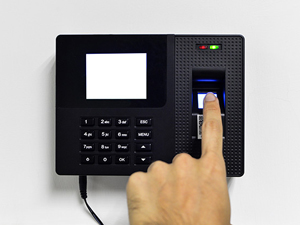



Date:31/03/18
 Spiceworks has announced the results of a new survey examining the adoption and security of biometric authentication technology in the workplace. The results show 62 percent of organizations currently use biometric authentication technology, and an additional 24 percent plan to utilize it within the next two years. The findings indicate that although most IT professionals believe biometric authentication is more secure than traditional forms of authentication, such as text-based passwords, PIN numbers, and personal security questions, only 10 percent of respondents believe biometrics are secure enough to be used as the sole form of authentication.
Spiceworks has announced the results of a new survey examining the adoption and security of biometric authentication technology in the workplace. The results show 62 percent of organizations currently use biometric authentication technology, and an additional 24 percent plan to utilize it within the next two years. The findings indicate that although most IT professionals believe biometric authentication is more secure than traditional forms of authentication, such as text-based passwords, PIN numbers, and personal security questions, only 10 percent of respondents believe biometrics are secure enough to be used as the sole form of authentication.
Fingerprint and face scanners are most commonly used in the workplace
Fingerprint and face scanners are the most common types of biometric authentication used on corporate devices and services. The results show 57 percent of organizations are using fingerprint scanning technology, while 14 percent are using face recognition technology. Other biometric methods utilized include hand geometry recognition (5 percent), iris scanning technology (3 percent), voice recognition (2 percent), and palm-vein recognition (2 percent).
When further examining the types of fingerprint scanners organizations are using on company devices and services, the results show Apple Touch ID is the most commonly used at 34 percent, followed by Lenovo Fingerprint Manager (13 percent) and Samsung fingerprint readers (13 percent). Eleven percent of organizations are also using fingerprint scanners from Microsoft and Dell, while 23 percent are using fingerprint scanners from other vendors. Additionally, when examining the specific types of face and iris recognition technologies utilized, the results show 14 percent of organizations are using Apple Face ID, 13 percent are using Microsoft face login via Windows Hello, and 7 percent are using Android Face Unlock.
While 46 percent of organizations utilize biometric authentication on smartphones, 25 percent use it to authentication employees on laptops and 22 percent use it on tablets. Additionally, 17 percent of organizations use biometrics to verify employees on time clock systems, and 11 percent use it on door locks for the server room. Other uses for biometrics in the workplace include technology to authenticate employees on applications with sensitive data, wearables, and email.
A lack of transparency exists around the security of biometrics
Although biometric authentication in the workplace is already commonplace, many IT professionals still don’t trust the technology. More than 50 percent of IT professionals believe biometrics are harder to hack than traditional text-based passwords, but only 23 percent believe biometric authentication will replace traditional text-based passwords in the next two to three years.
IT professionals’ distrust around biometrics is potentially due to a lack of transparency from vendors around the security risks. According to the survey results, 65 percent of IT professionals believe there’s not enough transparency about the vulnerabilities discovered in biometric systems, and 63 percent believe there isn’t enough transparency regarding the privacy of biometric data collected by vendors. In fact, nearly 60 percent of IT professionals said they need more information about where technology vendors store biometric data.
“Many IT professionals aren’t convinced biometrics can serve as a secure and reliable replacement for the standard username and password combo,” said Peter Tsai, senior technology analyst at Spiceworks. “Unless technology vendors can address the security issues and privacy concerns associated with biometrics, the technology will likely be used side-by-side in the workplace with traditional passwords or as a secondary authentication factor for the foreseeable future.”
Methodology
The Spiceworks survey was conducted in 2018 and included 492 respondents from North America and Europe. Respondents are among the millions of IT professionals in Spiceworks and represent a variety of company sizes, including small-to-medium-sized businesses and enterprises. Respondents come from a variety of industries, including manufacturing, healthcare, nonprofits, education, government, and finance.
Spiceworks Study Reveals Nearly 90 Percent of Businesses Will Use Biometric Authentication Technology by 2020
 Spiceworks has announced the results of a new survey examining the adoption and security of biometric authentication technology in the workplace. The results show 62 percent of organizations currently use biometric authentication technology, and an additional 24 percent plan to utilize it within the next two years. The findings indicate that although most IT professionals believe biometric authentication is more secure than traditional forms of authentication, such as text-based passwords, PIN numbers, and personal security questions, only 10 percent of respondents believe biometrics are secure enough to be used as the sole form of authentication.
Spiceworks has announced the results of a new survey examining the adoption and security of biometric authentication technology in the workplace. The results show 62 percent of organizations currently use biometric authentication technology, and an additional 24 percent plan to utilize it within the next two years. The findings indicate that although most IT professionals believe biometric authentication is more secure than traditional forms of authentication, such as text-based passwords, PIN numbers, and personal security questions, only 10 percent of respondents believe biometrics are secure enough to be used as the sole form of authentication.Fingerprint and face scanners are most commonly used in the workplace
Fingerprint and face scanners are the most common types of biometric authentication used on corporate devices and services. The results show 57 percent of organizations are using fingerprint scanning technology, while 14 percent are using face recognition technology. Other biometric methods utilized include hand geometry recognition (5 percent), iris scanning technology (3 percent), voice recognition (2 percent), and palm-vein recognition (2 percent).
When further examining the types of fingerprint scanners organizations are using on company devices and services, the results show Apple Touch ID is the most commonly used at 34 percent, followed by Lenovo Fingerprint Manager (13 percent) and Samsung fingerprint readers (13 percent). Eleven percent of organizations are also using fingerprint scanners from Microsoft and Dell, while 23 percent are using fingerprint scanners from other vendors. Additionally, when examining the specific types of face and iris recognition technologies utilized, the results show 14 percent of organizations are using Apple Face ID, 13 percent are using Microsoft face login via Windows Hello, and 7 percent are using Android Face Unlock.
While 46 percent of organizations utilize biometric authentication on smartphones, 25 percent use it to authentication employees on laptops and 22 percent use it on tablets. Additionally, 17 percent of organizations use biometrics to verify employees on time clock systems, and 11 percent use it on door locks for the server room. Other uses for biometrics in the workplace include technology to authenticate employees on applications with sensitive data, wearables, and email.
A lack of transparency exists around the security of biometrics
Although biometric authentication in the workplace is already commonplace, many IT professionals still don’t trust the technology. More than 50 percent of IT professionals believe biometrics are harder to hack than traditional text-based passwords, but only 23 percent believe biometric authentication will replace traditional text-based passwords in the next two to three years.
IT professionals’ distrust around biometrics is potentially due to a lack of transparency from vendors around the security risks. According to the survey results, 65 percent of IT professionals believe there’s not enough transparency about the vulnerabilities discovered in biometric systems, and 63 percent believe there isn’t enough transparency regarding the privacy of biometric data collected by vendors. In fact, nearly 60 percent of IT professionals said they need more information about where technology vendors store biometric data.
“Many IT professionals aren’t convinced biometrics can serve as a secure and reliable replacement for the standard username and password combo,” said Peter Tsai, senior technology analyst at Spiceworks. “Unless technology vendors can address the security issues and privacy concerns associated with biometrics, the technology will likely be used side-by-side in the workplace with traditional passwords or as a secondary authentication factor for the foreseeable future.”
Methodology
The Spiceworks survey was conducted in 2018 and included 492 respondents from North America and Europe. Respondents are among the millions of IT professionals in Spiceworks and represent a variety of company sizes, including small-to-medium-sized businesses and enterprises. Respondents come from a variety of industries, including manufacturing, healthcare, nonprofits, education, government, and finance.
Views: 543
©ictnews.az. All rights reserved.Similar news
- Mobile operators of national market to reduce roaming tariffs
- Iran vows to unplug Internet
- China Targeting Telecoms in Corruption Probe
- Bangladesh to use electronic voting system for next elections
- Philippine IT sector to launch five-year digital strategy plan
- Russian Premier Vladimir Putin meets ITU Secretary-General Hamadoun Touré
- US lawmakers propose to regulate use of geolocation data
- Unlimited mobile data plans dying as telcos gear up for cloud future
- Europe at risk of falling behind US and Asia on 4G use
- Netherlands first to regulate on net neutrality
- Korean Co Takes Aim At Display Patents
- Regulators, Banks Look for IT Hires After Breakdowns
- Electron transactions spreading
- Schools in remote rural areas will connect to the single database via network without SIM
- Obama to Personally Tweet From Twitter Account





















